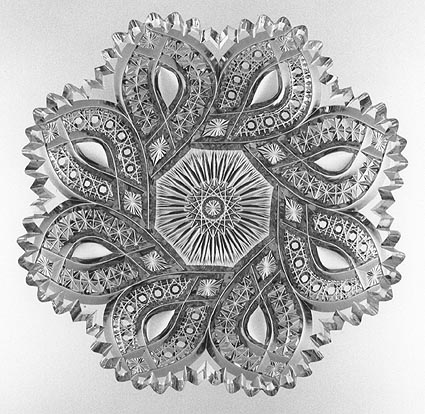
001. The "Necklace" pattern: An unknown pattern on an individual cake plate; a matching 10"D plate has also been seen in this pattern, which an example of American brilliant-period cut glass of high quality. The loops are composed of cane and quarter-diamond motifs, alternatingly. They enclose smooth, three-dimensional cut-glass cabochans produced by pillar-cutting. The pattern undoubtedly was designed and cut by a major manufacturer who also is unknown. Because items such as this are "out there", waiting to be discovered, collectors who feel put-upon by hyped "rarities" that carry hefty price tags should take heart! D = 7" (17.8 cm), wt = 1.25 lb (0.6 kg). Sold for $275 in 1990.

002. A pattern similar to Hoare's Pluto: This distinctive design can only have been cut by J. Hoare & Company. In fact the pattern is identical to Hoare's Pluto pattern (c1909) except that here the chain of boxed hobstars has been replaced with cane. D = 6" (15.2 cm), H = 5" (12.7 cm), wt = 2.75 lb (1.2 kg). Sold for $150 at an eBay auction in 2004 (Image: Internet).
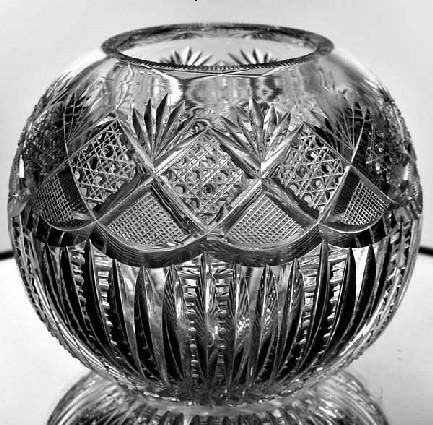
003. "Crescents & Stars": This name replaces "New Moon and Stars", an inappropriate name assigned by some collectors several years ago, but not universally accepted. The pattern is reminiscent of the logo used by the American Cut Glass Association (ACGA). (Also shown in the fourth book by Boggess and Boggess, p. 201.) Acid polished. D = 9" (22.9 cm) (Image: private collection).
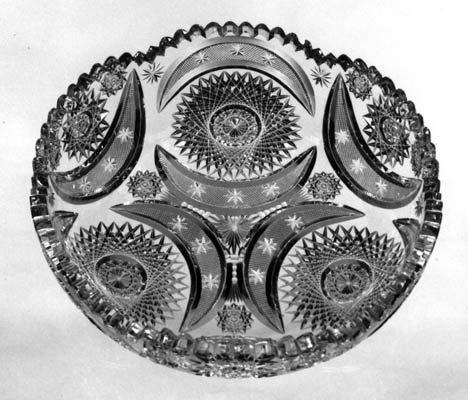
004. "Quatrefoil": A thoroughly satisfactory design, signed Hawkes, displayed on a typical 7"D (17.8 cm) plate. (Also shown in the third book by Boggess and Boggess, p. 50.) Sold for $416 at an eBay auction in 2004 (Image: Internet).
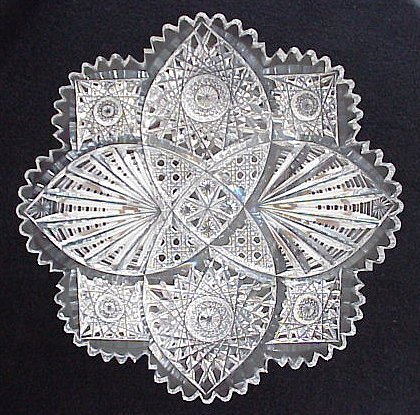
005. IDENTIFICATION CONFIRMED. The Jewel pattern by the Phoenix Glass Company, Monaca, PA: This pattern is shown on a bowl-shaped shade for a ceiling fixture in the company's 1893 catalog (reprinted in Pyne Press 1972: PENNSYLVANIA GLASSWARE, 1870-1904, pp. 45-69). The smallest shade in this pattern, one with a diameter of 10", retailed at $27,50 while the largest shade, 16"D, cost $90.00 The illustration in this catalog shows the step-cutting motif which is usually present on flatware but not on hollowware (for example, Boggess and Boggess, book 1, illus. 168A). An illustration of a berry bowl in this pattern, complete with an identical rim -- but with the step-cutting motif hidden -- is illustrated in an article by Ken Howe (please see the howe1.htm file in Part 1), p. 16 where it is stated that the Jewel pattern was announced in March 1888. It was probably cut until about 1894 when the company began de-emphasizing rich-cut tableware. Thereafter, the Jewel pattern was probably confined to lamp shades where it appears, together with other rich-cut patterns, as late as 1904 (Phoenix Glass Company's 1904 catalog no. 16, plate 11 shown in Howe). D = 9" (22.9 cm), H = 3" (7.6 cm), wt = 4 lb (1.8 kg)(Image: private collection).
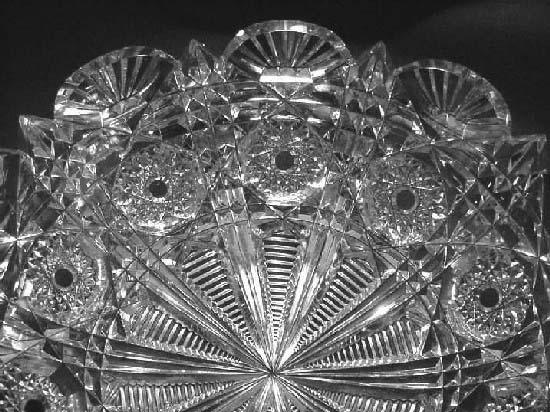
The following rose bowl in this pattern was offered for sale during 2006. The seller did not realize that this is the Jewel pattern by Phoenix. Note the elaborate, flashed hobstar in the base of the rose bowl.D = 6.5" (16.5 cm), H = 5.75" (14.6 cm) (Images: Internet).
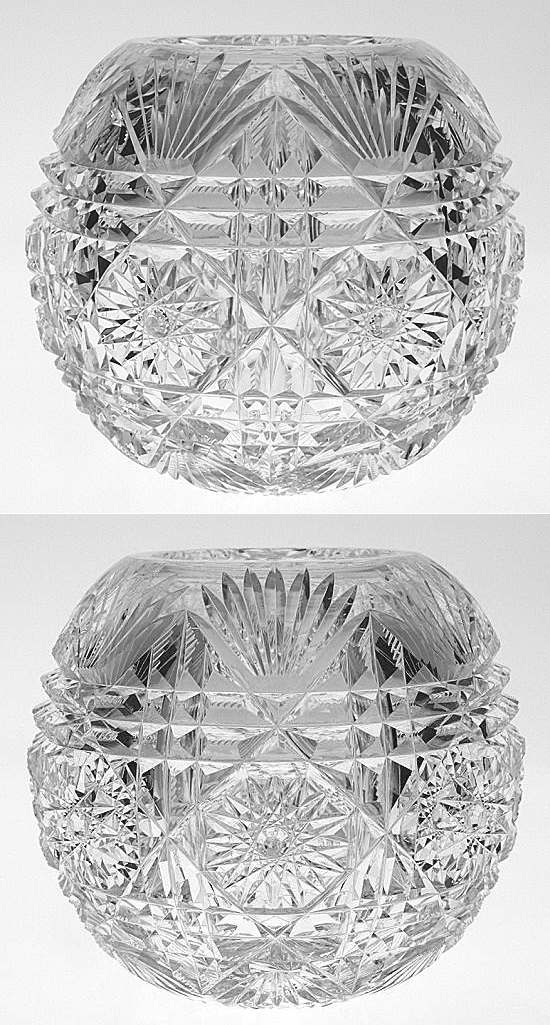
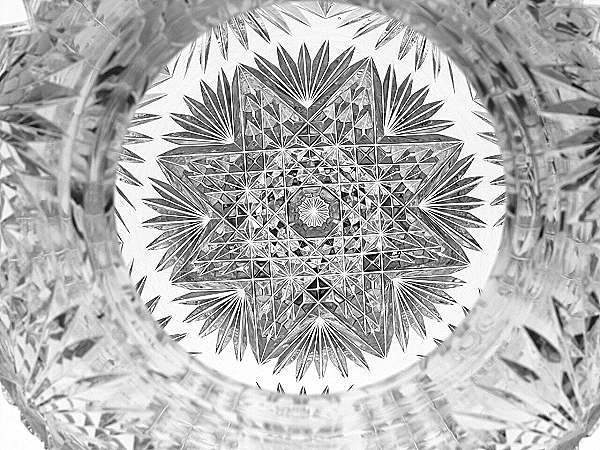
006. Celery tray cut in a pattern by Hawkes (signed): The pattern shares a chain-of-hobstars design that is also found in Hawkes' patented Nelson pattern of 1897. There is a possibility that this pattern is found only on shapes with an undulating rim; it gives this tray a modern look. c1900. L = 10.5" (26.7 cm), W = 7.3" (18.5 cm), H = 3.2" (8.1 cm), wt = 4.2 lb (1.9 kg). This item did not sell at an eBay auction in 2004 because the maximum price bid ($212.50) failed to equal the seller's reserve (Image: Internet).
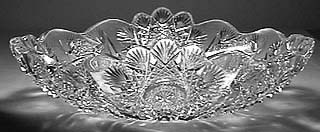
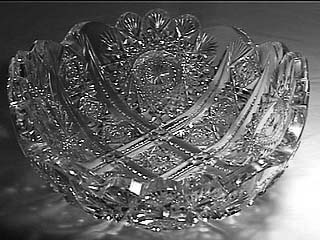
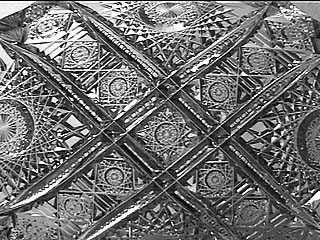

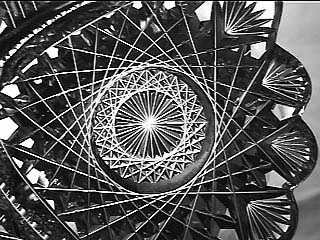
007. Color Cut-to-Clear. Pattern and manufacturer unknown. This wine glass might be a foreign import. It was offered for sale as Dorflinger but with a question mark. Set of 8 wine glasses, one glass with a rim chip, in red cut-to-clear. 32-pt star on base. H = 4.87" (12.4 cm), base D = 2.5" (6.4 cm). The set sold for $2,492 at an eBay auction in 2004.
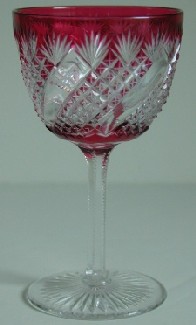
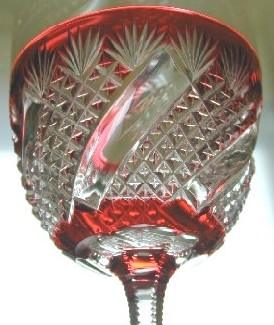

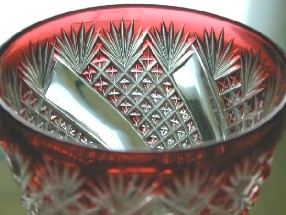
008. "Holly Wood". This is likely the correct name for this pattern because of comments made by Daniel in her second book on cut glass (1967, pp. 68-9) where Isador N. Steinberg provides a drawing of it. When she first reported the pattern, Daniel spelled it "Hollywood" (1950, p. 377) but in the interim she apparently had seen the name in print as "Holly Wood". This suggests that this is actually a catalog-name and not a name assigned ("coined") by Daniel herself. The pattern is an especially interesting one, not only because it is so seldom seen, but also because it was undoubtedly expensive to produce. Nevertheless, in 1967 Daniel estimated that a bowl of the size illustrated here could have been purchased for about $42! It is also an important item because it is the only example seen by the writer that combines the Hawkes U-notch with the earlier style of fan scallop. All other Hawkes examples seen to date use the later (the so-called usual) type of fan-scalloped rim (Please see the rim2.htm file in Part 1 for details.). Consequently, the bowl could either have been cut by Hawkes at a time when the company was experimenting with various types of fan scallops (compare, for example, the patent photographs for Hawkes' patterns of the late 1880s), or else it could have been produced by a company other than Hawkes. This latter possibility seem unlikely, however, because of the pattern's similarity to Hawkes' Grecian pattern, as indicated below.
Because of the bowl's rim, it can be stated with some confidence that the bowl was produced between 1887 and 1893. It is clear to this writer (but was not to Daniel) that the pattern is a variation of Hawkes' Grecian and, therefore, post-dates Grecian's patent-date (1887). In this example a large 16-pt hobstar is used in place of the 6- to 10-pt hobstars usually found on items cut in the Grecian pattern. The use of a 16-pt hobstar on a 10"D bowl does not permit the cutting of Grecian's "banners". They are reduced to simple notching between the vesicas. (The 12-pt flashed hobstar in the base of the bowl is incidental to this border-type pattern.) The mitered outline can be classified as hobstar extended, a style that was probably first used by Hawkes in the Grecian pattern. The "extensions" are the vesicas at the points of the large hobstar. The latter date, 1893, is suggested by the time when several other companies changed from the earlier to the later style of fan scallop. Berry bowl cut by an unidentified company in the "Holly Wood" pattern. D = 10" (25.4 cm), H = 4.75" (12.1 cm) (Images: Internet, Biden/Steele).
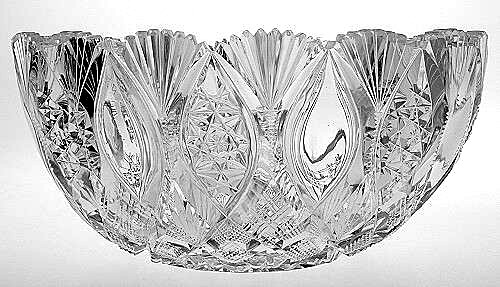
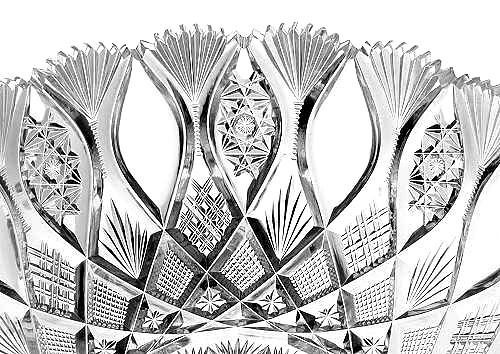


009. "Gloria". Two more fine photos by Biden/Steele. The problem is two-fold: to verify that this large plate is a Libbey product and to discover its official name.
Plate. D = 13" (33.0 cm), H = 1.37" (3.5 cm). Sold at an eBay auction for $1,225 in 2005 (Image: Internet).
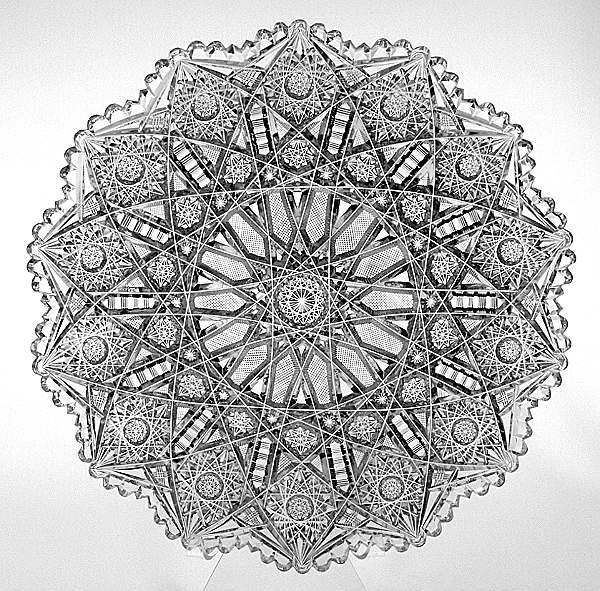
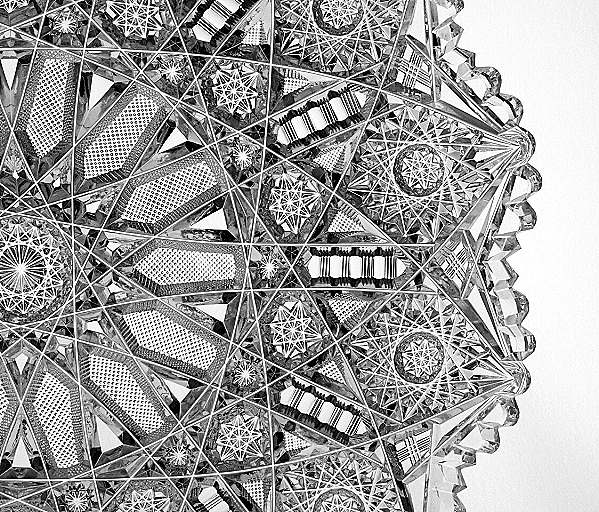
010. Probably American or English. See fig. 48 (p. 31) in Spillman and Frantz, 1990 for a similar American example. Possibly by Dummer (New Jersey Glass Company). Also see chapter 14: "Cut glass after 1851 and the rise of the brilliant cut style" (pp. 359-73) in Hajdamach, 1991 for a similar English example. A few repairable chips. L = 14" (35.6 cm), W = 8.75" (22,2 cm), H = 3" (7.6 cm), wt = 4.2 lb (1.9 kg). Sold for $500 as an American product at an eBay auction in 2005 (Images: Internet).
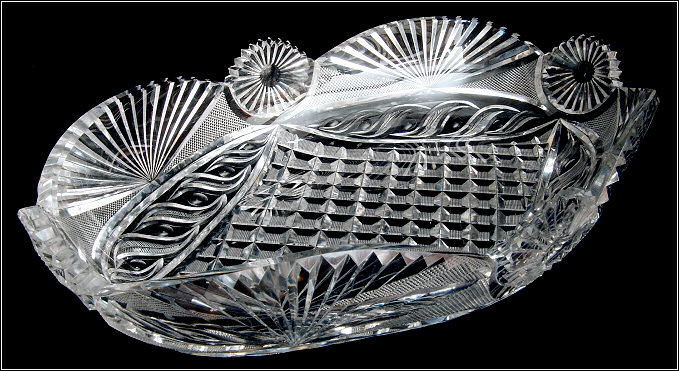
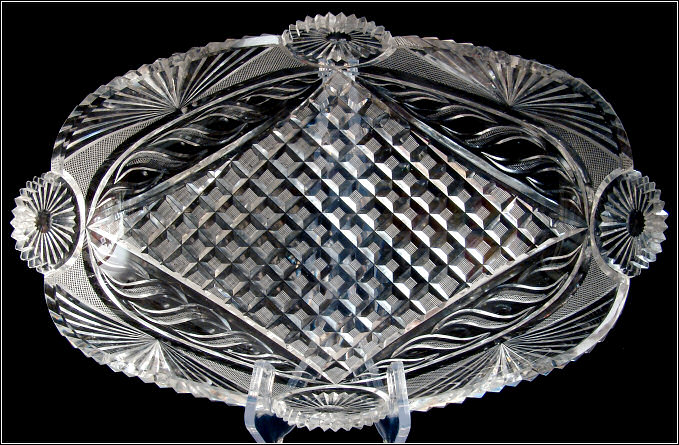
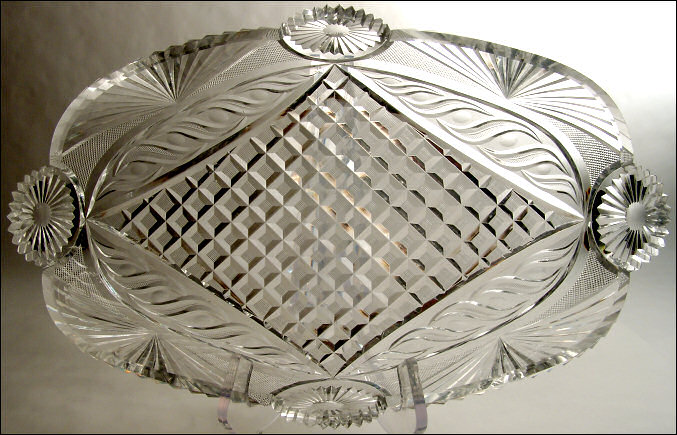
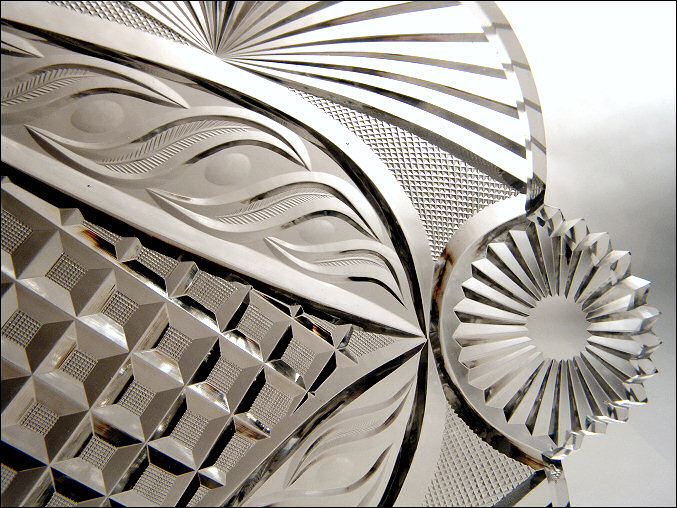
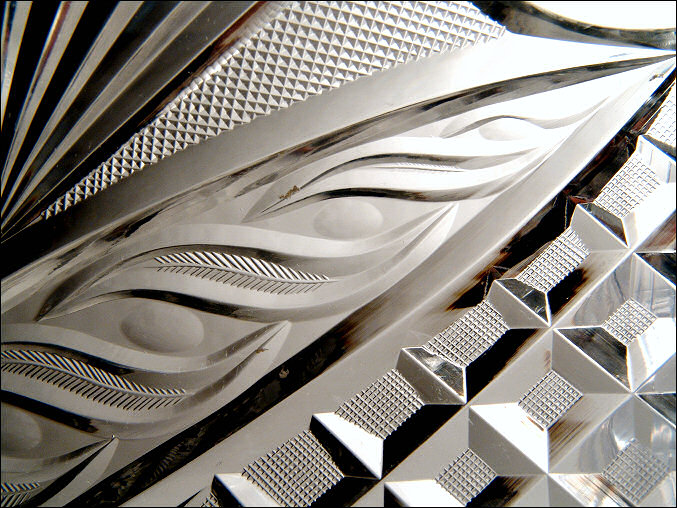
011. An Unidentified Pattern by Libbey. Signed with the Libbey-within-a-circle trademark (no. 9.3) Shown on an ice-cream tray that the seller states is "figured". L = 13.1" (33.3 cm), W = 10.75" (27.3 cm), H = 1.1" (2.8 cm), wt = 3.5 lb (1.6 kg). Sold for $272 at an eBay auction in 2006 (Images: Internet).

012. The "Assyrian Variation" Pattern. Manufacturer and pattern name unknown. As shown below, the principal difference between this pattern and Sinclaire's patented Assyrian pattern is the cutting on the hobnails. Here there is a single star while on the patent the hobnail is cut with a Brunswick star. Also note that the "channel cuts" are narrower in the variation than in the patent. It is usually assumed that the patented pattern and its variation were both cut c1909-c1918. The patented pattern has been found signed Sinclaire, but thus far no signature has been found on the patent's variation. What is the official name of "Assyrian Variation" and who cut it? D = 8" (20.3 cm), H = 1.9" (4.8 cm), w = 1.75 lb (0.8 kg). Sold for $860 at an e-Bay auction in 2006.
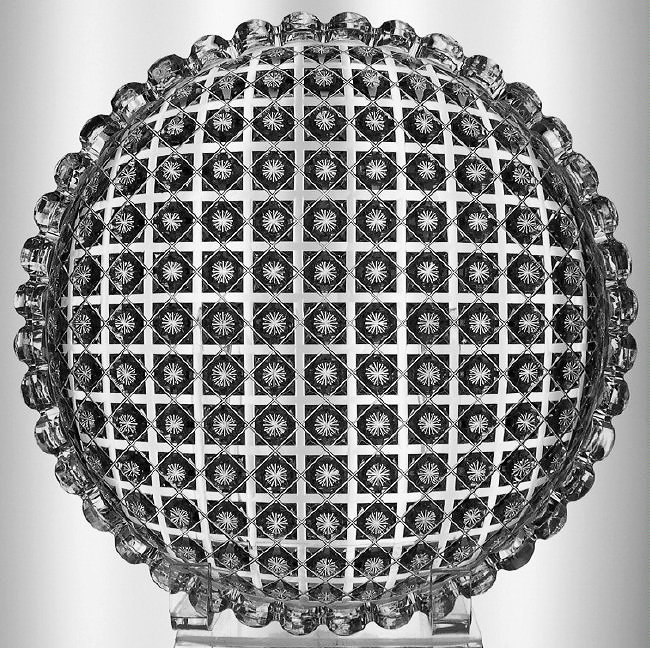

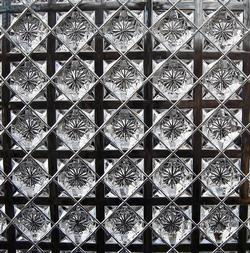


Here is the patented Assyrian pattern by Sinclaire (pat. no. 40,196) Note that this illustration is rotated 45 deg relative to the illustrated examples of the patent's variation:
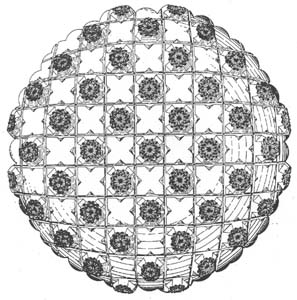
Updated 1 May 2007